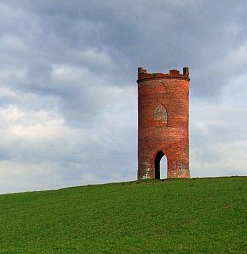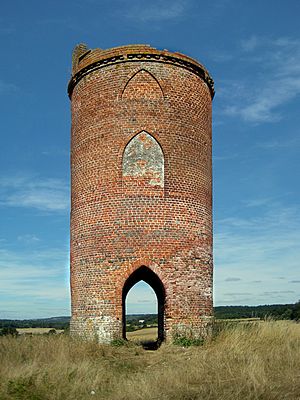Wilder's Folly facts for kids
Quick facts for kids Wilder's Folly |
|
|---|---|

Wilder's Folly on Nunhide Hill
|
|
| Alternative names | Pincent's Kiln, Nunhide Tower and Flint's Folly |
| General information | |
| Type | Folly, belvedere, dovecote |
| Architectural style | Eclectic, neoclassical |
| Location | Sulham, Berkshire, UK |
| Country | United Kingdom |
| Coordinates | 51°26′53″N 1°04′02″W / 51.44819°N 1.06725°W |
| Completed | 1769 |
| Client | Henry Wilder |
Wilder's Folly is a unique old building located on Nunhide Hill, near the village of Sulham in Berkshire, England. It's also known by other names like Pincent's Kiln, Nunhide Tower, and Flint's Folly. This interesting structure is a type of building called a folly, which means it was built mostly for decoration. It also served as a dovecote, a place where doves or pigeons live.
The Story Behind Wilder's Folly
Wilder's Folly was built in 1769. It was constructed by a man named Reverend Henry Wilder. He built it while he was trying to win the heart of Joan Thoyts. She was the younger sister of John Thoyts, who lived at Sulhamstead House.
Reverend Wilder wanted the tower to be seen from Joan's home. It was also visible from his own house, Sulham House. Today, you can still see Sulham House through the south arch of Wilder's Folly. However, Sulhamstead House is no longer visible from the top of the hill. Henry Wilder and Joan Thoyts got married on June 13, 1769. They went on to have eleven children together.
What the Building Looked Like
This brick tower was originally called a belvedere. This means it was a building designed to offer a beautiful view.
The ground floor of Wilder's Folly had an open arcade. This is like a series of arches. To get to the first floor, which was a painted room, people used an outside wooden staircase. The two floors above the ground level had special windows called ogive windows, which were glazed. The very top of the tower was castellated, meaning it looked like the top of a castle wall. It had a flat lead roof.
Later, in the late 1800s, the building changed. Its windows were bricked up, and the tower became a dovecote. This means it was used to house doves or pigeons.


